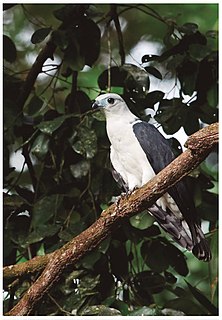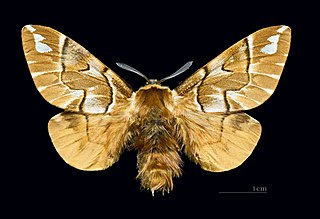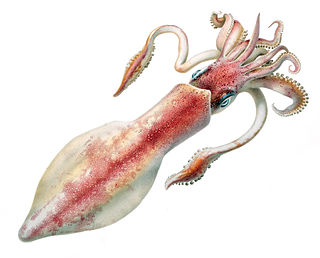
The blue-breasted kingfisher is a tree kingfisher widely distributed across Equatorial Africa. This kingfisher is essentially resident, but retreats from drier savanna areas to wetter habitats in the dry season.

The white-collared kite is a South American raptor. It is endemic to northeastern Brazil.

Endromidae is a family of moths. It was long considered to be a monotypic family, containing just one species, the Kentish glory, Endromis versicolora, found throughout the Palaearctic region. The family now consists of several genera and about 30 species, all former members of the family Bombycidae.

The Chatham parakeet(Cyanoramphus forbesi), also known as Forbes' parakeet, is a rare parakeet endemic to the Chatham Islands group, New Zealand. This parakeet is one of New Zealand's rarest birds and is classified as Vulnerable on the IUCN Red List, as a result of a range of threats to the species survival, including habitat loss, predation, and hybridization. A number of conservation methods have been employed to assist the recovery of this species, and currently the population trend is considered stable.
The greater tree mouse is a species of rodent in the family Muridae. It is found only in Papua New Guinea.

The painted ringtail possum or moss-forest ringtail possum is a species of marsupial in the family Pseudocheiridae. It is found in Papua New Guinea.

William Alexander Forbes was an English zoologist. He was the son of James Staats Forbes (1823–1904).

Loligo forbesii, known commonly as the veined squid and long-finned squid, is a commercially important species of squid in the family Loliginidae, the pencil squids.

Sarothruridae is a family of small- to medium-sized ground-living birds found mostly in Madagascar and sub-Saharan Africa, with the genus Rallicula being restricted to New Guinea and the Moluccas. The species in this family were once considered to sit with the larger rail family Rallidae.

The barrens darter is a species of freshwater ray-finned fish, a darter from the subfamily Etheostomatinae, part of the family Percidae, which also contains the perches, ruffes and pikeperches. It is endemic to the eastern United States, where it is only known from the Cumberland ecoregion. It inhabits generally quiet pools in headwaters and creeks, often sheltering underneath large rocks. This species can reach a standard length of 7.4 cm (2.9 in). This species forms part of the Etheostoma squamiceps species complex within the subgenus Catonotus and it is further part of the "blackfin darter" group. It was first formally described in 1992 by Lawrence M. Page and Patrick A. Ceas with its type locality given as Duke Creek which is 3.2 kilometres (2.0 mi) southeast of Hollow Springs in Cannon County, Tennessee. The specific name honours Stephen A. Forbes, who was a noted ichthyologist member of the Illinois Natural History Survey during the early part of the 20th century.
Sesquiluna is a genus of moths of the Endromidae family.

Asterias forbesi, commonly known as Forbes sea star, is a species of starfish in the family Asteriidae. It is found in shallow waters in the northwest Atlantic Ocean and the Caribbean Sea.
The D'Entrecasteaux Archipelago pogonomys, also known as the D'Entrecasteaux Archipelago tree mouse, is a species of prehensile-tailed rat from the family Muridae that is endemic to Papua New Guinea. It was once considered to be a subspecies of the Large Tree Mouse. Deforestation is posing a threat to the species, but it has been suspected that the species has some degree of tolerance towards disturbance of its habitat.
Sesquiluna albilunata is a moth in the family Endromidae first described by George Hampson in 1910. It is found in Assam, India.
Sesquiluna theophoboides is a moth in the Endromidae family. It is found in Vietnam.
Jana forbesi is a moth in the family Eupterotidae. It was described by Lucien A. Berger in 1980. It is found in Orientale Province of the Democratic Republic of the Congo and in Malawi.
Rothschildia forbesi, the Forbes' silkmoth, is a species of silkmoth in the family Saturniidae.
Aspitates forbesi is a species of geometrid moth in the family Geometridae. It is found in North America.
Anacropora forbesi is a species of briar coral that can be found in the tropical western and central Indo-Pacific region. It is the type species of the genus Anacropora.

Oecanthus forbesi, the Forbes' tree cricket, is a species of tree cricket in the family Gryllidae. It is found in North America.










